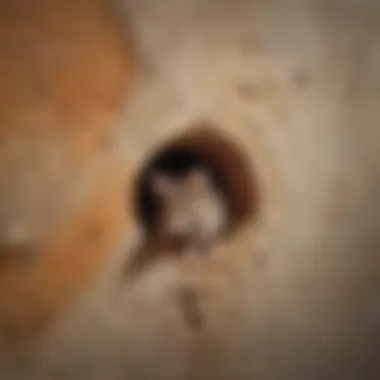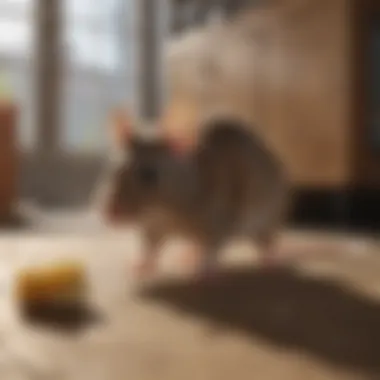Understanding Mouse Entry Points in Homes


Intro
Understanding how mice enter our homes is crucial for effective prevention and control. These small rodents, often considered harmless, can cause significant damage and pose health risks. Knowing the anatomy and habits of mice can help homeowners identify potential entry points and attractants. This guide aims to empower individuals with knowledge about mouse behavior, emphasizing practical strategies to secure living spaces against these uninvited guests.
Pest Identification
Detailed Descriptions of Common Pests
Mice are typically small mammals that belong to the family Muridae. Two of the most common types found in urban and suburban areas are the house mouse and the field mouse. The house mouse, scientifically known as Mus musculus, has a slender body, large ears, and a long tail. Its fur is generally brown or gray, often with whitish underparts. The field mouse, on the other hand, is slightly larger and usually found in rural areas, with similar coloration but more pronounced features.
Signs and Symptoms of Infestations
Detecting a mouse infestation early can prevent larger problems. Common signs include:
- Droppings: Small, pellet-like droppings scattered around food sources.
- Nesting Materials: Shredded paper, fabric, or insulation found in hidden areas.
- Gnaw Marks: Chewed edges on food packaging or structural materials.
- Tracks: Visible footprints, often in dusty areas.
- Nocturnal Noises: Scratching or scurrying sounds at night, when mice are most active.
Identifying these signs promptly can help in addressing the issue before it escalates.
Prevention Strategies
Home Maintenance Tips for Pest Prevention
Preventing mice from entering your home requires ongoing diligence. Some effective home maintenance tips include:
- Sealing Cracks: Inspect the exterior of your home for cracks or gaps, especially around windows, doors, and foundations.
- Capping Vent Spaces: Ensure that vents are covered with screens to block entry.
- Proper Food Storage: Storing food in airtight containers will minimize attractants.
- Regular Cleanliness: Keeping your home clean eliminates food sources. Regular vacuuming is essential.
Natural Deterrents and Barriers
In addition to maintenance, consider using natural deterrents. Several natural substances can deter mice effectively:
- Peppermint Oil: Strong scent that mice tend to avoid.
- Ultrasonic Repellents: Devices that emit high-frequency sound waves can also keep mice at bay.
Using a combination of physical barriers and natural repellents increases the chances of success in keeping your home pest-free.
Treatment Options
Overview of Chemical vs. Natural Treatments
When it comes to managing an existing mouse problem, choosing the right treatment method is essential. Chemical treatments often include rodenticides. These are effective but should be handled with care due to potential risks to children and pets. On the other hand, natural treatments include traps and repellents, which can be safer.
Step-By-Step Guides for DIY Treatments
For homeowners looking to address the issue themselves, DIY treatments can be practical. Here’s a brief guide:
- Set Traps: Place snap traps in areas where signs of mice are evident.
- Use Baits: Peanut butter is a good bait option for traps.
- Monitor: Check traps regularly to ensure removal of caught mice promptly.
Finally, prevention is the key to avoiding infestations in the first place. By understanding how mice get into houses, you can effectively manage and secure your home.
Prologue to Mouse Infestation
Mice pose a significant concern for homeowners. Understanding how these rodents infiltrate homes can minimize risks and promote a healthier living environment. The goal here is to delve into the specific behaviors and characteristics of mice and establish an effective framework for managing infestations.
Understanding Mice Behavior
Mice are resilient creatures. Their small size allows them to navigate through tight spaces. Generally, they are nocturnal, making it challenging to spot them during the day. Mice are primarily attracted to food and warmth. They often seek shelter during colder months, which makes houses appealing.
These rodents are also known for their quick reproduction rates. A single female can produce several litters annually, leading to rapid population growth. This inherent trait necessitates understanding their behavior to manage and prevent infestations effectively.
Moreover, mice are cautious creatures. They tend not to wander too far from their nests, relying on their keen sense of smell to locate food and shelter. A thorough knowledge of this behavior can help homeowners take preemptive action in safeguarding their homes.
Importance of Identifying Entry Points
Detecting and understanding entry points is paramount. Mice can exploit the smallest of gaps. By identifying where they can enter, homeowners can take proactive measures to seal these vulnerabilities.
Common entry points include:
- Cracks in foundations
- Small holes around plumbing
- Gaps in windows and doors
These openings allow mice to slip inside unnoticed. If left unaddressed, they can lead to larger infestations. Regular inspections of a home’s exterior can help spot potential entry points.
Common Routes of Entry


Understanding the common routes of entry for mice is essential for homeowners who wish to maintain a rodent-free environment. Mice are incredibly resourceful creatures, capable of infiltrating homes through surprisingly small openings. By recognizing these potential entry points, one can take proactive measures to prevent infestations before they start.
In this section, we will examine the most frequent avenues through which mice gain access to homes. This knowledge is crucial not only to safeguard your living space but also to foster a more comfortable and hygienic environment for your family.
Cracks and Gaps in Foundations
Foundations often develop cracks over time due to settling or poor initial construction. These fissures can be a significant entry point for mice. Mice can squeeze through openings as small as a quarter of an inch wide. It is imperative for homeowners to regularly inspect their foundations for any signs of deterioration.
Key steps to address this issue include:
- Sealing cracks: Utilize epoxy or concrete fillers to seal any visible cracks.
- Regular inspections: Periodically check for new cracks and address them immediately.
- Landscape management: Ensure that soil and mulch do not pile up against the foundation, creating additional pathways for mice.
Doors and Windows
Doors and windows are traditional entry points for various pests, including mice. Gaps around these structures can be quite inviting, particularly if they are not properly sealed.
Consider the following measures to reinforce these areas:
- Weather stripping: Install or replace weather stripping to eliminate gaps under doors and around window frames.
- Screening: For windows that are frequently opened, use fine mesh screens to secure openings.
- Tight-fitting doors: Ensure doors close completely and fit snugly within their frames to minimize potential entry points.
Vents and Ducts
Ventilation systems serve a critical role in maintaining indoor air quality. However, they can also act as conduits for mice if not adequately covered. Mice can enter homes through vents in the attic or basement, leading to more extensive infestations.
Effective preventative measures include:
- Installing vent covers: Use sturdy covers to keep vents and ducts secure against unwanted intruders.
- Regular cleaning: Frequent maintenance of your ventilation systems can help spot potential entry issues before they escalate.
Plumbing and Electrical Entries
Mice can also access homes through gaps around plumbing and electrical conduits. Common sources include open spaces where pipes enter walls or floors.
To curb this risk, take steps such as:
- Sealing gaps: Apply expandable foam or other sealing compounds around the entry points of plumbing and electrical lines.
- Routine checks: Inspect areas where utilities enter your home for any openings or deterioration.
By understanding these routes of entry, homeowners can implement effective strategies to protect their living space from unwanted pests. Awareness and proactive measures can make a significant difference in preventing mouse infestations.
Life Cycle and Adaptations of Mice
Understanding the life cycle and adaptations of mice is essential in comprehending how they invade homes. It sheds light on their reproduction rates, survival skills and their ability to thrive in various environments. Knowledge of these elements can greatly assist homeowners in managing infestations and even preventing them from occurring.
Reproductive Behavior
Mice are known for their high reproductive capacity. Under optimal conditions, female mice can give birth to a litter of five to twelve pups approximately every three weeks. The gestation period lasts about 19 to 21 days. This rapid reproduction means that a small mouse population can quickly escalate, making it vital to address any sign of a mouse presence promptly.
Once born, the pups are initially helpless and rely on their mother. They grow rapidly and typically reach maturity in just six weeks. This quick developmental cycle allows for sustained mouse populations. With multiple litters possible in a year, the growth can become substantial. Thus, if any female mouse enters a home, she can establish a significant population in a short time frame, highlighting why understanding this behavior is crucial.
Survival Strategies
Mice possess remarkable adaptability regarding their survival strategies. They exhibit both physical and behavioral adaptations that allow them to thrive in a variety of environments, including urban settings. Their small size, averaging about 2.5 to 4 inches in length, enables them to exploit tiny gaps and holes in homes and buildings.
Mice are also nocturnal, which helps them stay hidden from predators while foraging for food. Their keen sense of smell and ability to explore can lead them to discover new food sources. They are opportunistic feeders, meaning they will eat almost anything, which further increases their chances of survival in diverse habitats.
Furthermore, mice build nests from available materials, including paper, fabric, and insulation. This behavior not only provides them shelter but also enables them to reproduce in proximity to food sources, enhancing their survival potential.
The adaptability of mice makes them difficult to manage and control in residential environments. It is essential to understand these factors to implement effective preventive measures.
By grasping the reproductive behaviors and survival strategies of mice, homeowners can take preemptive steps to keep their living spaces secure. Such insight can guide the implementation of new strategies to avoid infestations and reduce the chance of a small mouse problem escalating into a larger issue.
Factors Attracting Mice to Homes
Understanding what draws mice to residential spaces is crucial for prevention and effective management of infestations. We must consider environmental factors that create inviting conditions for these pests. Knowledge of what attracts mice can enable homeowners to make informed decisions that discourage their presence in and around their homes.
Food Sources
Mice are opportunistic feeders. They will consume almost anything they can find. Common food sources within homes include crumbs, pet food, and unsecured garbage. Even small amounts of food can be enticing to them. \n It is essential to ensure that food is stored in sealed containers. Glass or heavy plastic bins work well for this purpose. Additionally, keeping countertops clean and reducing clutter will minimize potential food sources.
"Eliminating accessible food is often the first step in keeping mice at bay."
Some specific areas to focus on include:


- Kitchen countertops: Always wipe surfaces after meal preparation.
- Pantry shelves: Store dry goods in airtight containers to deter access.
- Trash bins: Use bins with tight-fitting lids to prevent scavenging.
Shelter and Nesting Sites
Mice seek warmth and safety, especially during colder months. They favor secluded spaces that are undisturbed by human presence. Common nesting sites include attics, basements, and behind appliances. These areas often provide insulation and protection from potential threats. The availability of nesting materials, such as paper, fabric, or insulation, further enhances their attraction.
Homeowners should assess potential nesting areas regularly. A periodic check can prevent an unnoticed mouse population from growing. It is also prudent to declutter and organize spaces to deny mice opportunities for nesting.
Noteworthy points include:
- Insulation: Check for gaps in insulation that could provide entry.
- Storage: Use hard containers instead of cardboard boxes which are easy to tear.
- Lower cabinets: Keep them organized and avoid leaving items on the floor.
By recognizing and acting on the factors that entice mice into homes, effective strategies can be implemented to deter these unwanted guests.
Signs of Mice Infestation
Recognizing the signs of a mouse infestation is crucial for homeowners. Early detection can prevent extensive damage to property and protect against potential health risks. Mice are small, elusive creatures, making their presence challenging to identify at times. However, certain physical indicators and unusual auditory or olfactory cues can signify their presence.
Understanding these signs allows for timely intervention. It helps in deciding whether to take preventive action, set traps, or call professionals. Ignorance of these signs could lead to a larger infestation, increased costs, and health issues associated with rodent droppings and urine.
Physical Evidence
Physical evidence of mice often includes droppings, tracks, and damaged materials. Mice leave behind small, dark, pellet-like droppings, approximately 1/8 to 1/4 inch long. These are typically found where mice forage for food. If the droppings are fresh, they have a moist appearance and may be dark in color.
Another indicator is the presence of gnaw marks. Mice gnaw on various materials to keep their teeth from growing too long. This can include food packaging, wood, insulation, and even electrical wiring. Check for signs of chewing on edges or corners of furniture and walls.
Additionally, you might find nests. Mice build nests using shredded paper, fabric, or other soft materials. Their nests are often hidden in secluded areas such as behind appliances or in storage boxes. Tracking down these nests can provide insight into the size of the infestation.
Key Signs to Look For:
- Droppings: Near food sources or along walls.
- Gnaw marks: on furniture, food containers, or other materials.
- Nests: made from household materials near hidden corners.
Sounds and Smells
Mice are generally active during the night. Thus, they can produce various sounds that may be noticeable during quiet hours. Scratching noises in walls, ceilings, or below floors can hint at their movement. If you hear scurrying, it's likely that a mouse is navigating through the space, searching for food.
Their vocalizations can include high-pitched squeaks or chirps, sometimes overlooked in a busy household. Listening for noises can alert homeowners to a potential issue before it escalates.
Furthermore, mice produce distinct odors. The smell of a musky scent can indicate a mouse infestation. Their urine and droppings contribute to this smell, sometimes becoming more pungent if the infestation is severe.
Important Auditory Signs:
- Scratching sounds: in walls or between floorboards during nighttime.
- High-pitched squeaks: during movement or interactions with other mice.
By staying vigilant to both physical evidence and the auditory clues, homeowners can more effectively safeguard their homes from mice. Regular checks in suspected areas can significantly reduce the risk of a full-blown infestation.
Preventive Measures Against Mouse Entry
Preventing mice from entering your home is critical for maintaining a safe and healthy living environment. Effective prevention strategies can minimize potential infestations, save money on pest control services, and protect your property. Mice are resourceful and can fit through very small openings. Therefore, taking preventive measures helps to create physical barriers and remove attractants that would entice them into your space.
Sealing Entry Points
One of the most essential steps in mouse prevention is sealing entry points. Mice can enter through gaps, cracks, and holes as small as a quarter of an inch. To effectively seal these entry points, conduct a thorough inspection of your home’s exterior and interior.
Key areas to check include:
- Foundations: Look for cracks in the foundation walls; use caulk or expanding foam to fill these.
- Doors and windows: Ensure that all doors close tightly and that window screens are intact. Weather stripping can help close gaps.
- Vents and pipes: Inspect vents, as well as areas where pipes enter your home, and seal any openings.
- Siding and roofs: Examine the siding for gaps and ensure tiles or shingles are intact to prevent droppings or debris from creating openings.
By sealing entry points, you can greatly diminish the likelihood of mice entering your home.
Proper Food Storage
Another crucial aspect of prevention is effective food storage. Mice are driven by the need for food, and unsecured food sources can beckon them into your home. Take the following steps to secure your food:
- Use airtight containers: Keep all food in sealed containers. Glass or hard plastic containers work best.
- Store pet food properly: Pet food should also be kept in rodent-proof containers. Avoid leaving food out overnight.
- Minimize clutter: Reducing clutter can help limit mouse access to food sources. Regularly clean and organize pantry spaces.
Implementing proper food storage methods not only protects your food supplies but also reduces the chances of attracting unwanted rodents.
Regular Cleaning and Maintenance
Maintaining a clean environment is vital in preventing mice from settling in your home. Regular cleaning habits can eliminate potential food sources and nesting materials. Consider the following cleaning strategies:


- Frequent vacuuming: Vacuuming regularly can help to ensure that food crumbs or debris do not accumulate. Remember to pay special attention to overlooked areas, such as under appliances.
- Wipe down surfaces: Clean counters and tables to remove any food residue that might attract mice. The use of disinfectants can be beneficial in this regard.
- Dispose of garbage properly: Ensure that trash bins are sealed and emptied regularly. Keeping trash bags in a secure container can help prevent a mouse feast.
By maintaining cleanliness, homeowners can significantly reduce the chance of mouse infestation.
"An ounce of prevention is worth a pound of cure."
In summary, preventive measures against mouse entry cover sealing potential openings, securing food supplies, and implementing rigorous cleaning routines. These actions, when diligently practiced, can contribute significantly to a mouse-free home.
Treatment Options for Established Infestations
When dealing with a mouse infestation, understanding the available treatment options is crucial. Mice can reproduce quickly, so timely action is necessary to prevent further invasion and damage. The treatment not only focuses on eliminating existing mouse populations but also on ensuring that they do not return. Different methods can be employed, each with their own benefits and considerations.
Rodenticides and Traps
Rodenticides and traps are common methods for controlling mouse populations. Rodenticides are chemicals designed to kill rodents. They are available in various forms, including bait stations and pellets. Understanding how and when to use these products is vital for effectiveness. It is important to follow the instructions closely to avoid accidental poisoning of pets or non-target animals.
Traping is another effective method. There are two main types of traps: snap traps and glue traps. Snap traps are mechanical devices that kill a mouse almost instantly. These traps are reusable and can be placed in areas with high mouse activity. Glue traps, on the other hand, simply capture the mouse without killing it. This method requires monitoring as the captured mice may suffer.
Professional Pest Control Services
Engaging professional pest control services can be a wise decision for severe infestations. Pest control professionals possess specialized knowledge and tools that are not readily available to the average homeowner. They can accurately assess the situation and determine the most effective treatment strategies while considering the safety of other inhabitants and pets.
Professional services often employ Integrated Pest Management (IPM) techniques. This approach not only focuses on controlling the existing population but also aims to eradicate the factors that attract mice in the first place. An expert can also provide advice on preventive measures to deter future infestations, giving homeowners peace of mind.
In summary, whether using rodenticides, traps, or hiring professionals, understanding these treatment options is essential.
Debunking Common Myths About Mice
Understanding the various myths surrounding mice is essential for homeowners and those interested in pest control. Misconceptions can lead to ineffective strategies for dealing with mouse infestations. Addressing these myths promotes a more informed approach to prevention and treatment. This section aims to clarify common beliefs and misconceptions, leading to better management of mouse-related issues.
Myths vs. Facts
- Myth: Mice prefer dirty environments.
- Myth: A cat will eliminate mice problems.
- Myth: Mice infestations only occur in the winter months.
- Myth: If you see one mouse, there are hardly any more.
- Myth: Mice are harmless and won't cause significant damage.
- Fact: Mice are opportunistic feeders. They will invade areas with abundant food sources, regardless of cleanliness. Proper sanitation can deter mice, but it does not guarantee prevention.
- Fact: While cats are natural hunters, they might not be effective at controlling a mouse population. Some mice may hide or avoid areas where cats are present.
- Fact: Mice can invade homes at any time of the year. They seek shelter and food whenever conditions are favorable, not just during colder months.
- Fact: Mice reproduce rapidly. Spotting one may indicate a larger colony nearby. Immediate action is advisable once evidence of a mouse is found.
- Fact: Mice can cause severe destruction. They gnaw through wires, wood, and insulation, creating safety hazards and damaging property.
Understanding Mice Behavior Misconceptions
Many people fail to recognize the complexity of mouse behavior. Misunderstandings can influence how homeowners respond to an infestation. Here are a few key misconceptions:
- Misconception: Mice only come out at night.
- Misconception: All mice are a nuisance in the same way.
- Misconception: Mice can only enter homes through wide openings.
- In reality, while they are mostly nocturnal, they may venture out during the day, especially if food is readily available.
- Different species of mice may exhibit different habits. For instance, house mice may adapt easily to urban environments, while field mice often stay close to agricultural areas.
- Mice can squeeze through very small openings—about the size of a dime. Recognizing this can help in securing entry points.
"By debunking these myths, homeowners can improve their understanding of mice behavior, and effectively protect their homes from infestations."
To conclude, overcoming these misconceptions enables a proactive approach in preventing and managing mouse infestations. This insight empowers homeowners to apply effective strategies that consider the true nature of these pests.
Ending and Key Takeaways
In this article, we explored the various pathways that enable mice to intrude into residential spaces. Understanding mouse behavior and identifying key entry points are crucial elements in mitigating the risk of infestation. This section synthesizes the main insights and recommendations drawn from the previous discussions, emphasizing the importance of proactive measures against these nocturnal intruders.
Summary of Prevention Strategies
To effectively prevent mice from entering your home, several strategies are necessary. These strategies form a comprehensive approach that includes:
- Sealing Entry Points: Thoroughly inspect your home for cracks and gaps. Use appropriate materials like caulk or steel wool to seal these openings. Pay particular attention to areas around windows, doors, and foundations.
- Food Storage: Store food in airtight containers to reduce attractants. Ensure that pantry items are well secured to prevent easy access.
- Regular Cleaning and Maintenance: Consistent cleaning can deter mice. Remove clutter and regularly clean up crumbs or spills that might invite these rodents.
Adopting these measures not only helps in preventing a future infestation but also promotes a healthier living environment.
Final Thoughts on Managing Mouse Entry
Managing mouse entry into your home requires a vigilant and informed approach. Understanding that mice can fit through remarkably small openings underscores the necessity of preventive measures. Homeowners should regard these strategies not merely as temporary fixes but as ongoing habits to maintain. Being proactive can save time, money, and stress in the long run.
"An ounce of prevention is worth a pound of cure." - This proverb applies well in the context of pest management, reinforcing that taking early action can avert significant issues later.



